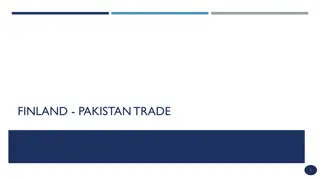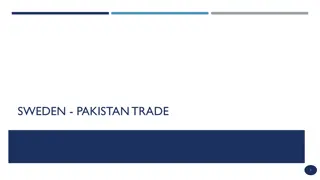Trade and Economy of Pakistan: A Comprehensive Overview
Pakistan's trade dynamics involve a mix of imports and exports crucial for its economic development. The country's major exports include raw cotton, textile products, rice, leather goods, and more. Efforts to increase exports have shown growth trends, but challenges like high imports and inflation persist. The trade scenario, mainly focusing on major export markets and products, plays a significant role in shaping Pakistan's economy.
Download Presentation

Please find below an Image/Link to download the presentation.
The content on the website is provided AS IS for your information and personal use only. It may not be sold, licensed, or shared on other websites without obtaining consent from the author. Download presentation by click this link. If you encounter any issues during the download, it is possible that the publisher has removed the file from their server.
E N D
Presentation Transcript
Trade of Pakistan Subject : Geography Of Pakistan
Export VS Import Import and export are terms that are commonly heard in international trade and these are activities that are carried out by all countries of the world. In general, import refers to an item coming inside a country from any other country while export refers to an item going out of the country to any other country of the world. Since no country in the world is self sufficient, all countries both import as well as export.
Export VS Import Export is the term used to selling of products or service from any other country while import is the activity of buying the same from other countries Both exports and imports are essential for the development of any country as no nation is self sufficient Problem arises when imports are too high while exports are to low leading to a serious balance of payment problem for a country.
Facts and Figures For the last 5 years it has averaged 6-7% growth. Pakistan had the narrow export base but due to govt. efforts it has been increased in the last five years. During the last five years, inflation has increased to a great extent. Currently the inflation rate is 25%. Pakistan earns a major portion of foreign exchange from the export of its products such as cotton products, scientific, medical & hospital equipment, Toys, bicycles and other sporting goods, etc. Civilian aircraft, Computer accessories, Telecommunications equipment, Tanks, artillery, missiles, rockets, guns & ammunition, etc are the major imports.
MAJOR EXPORTS 1. Raw cotton, Textile products and Cotton yarn. 2. Rice. 3. Leather and leather products. 4. Carpets and rugs, Tents. 5. Synthetic textiles. 6. Surgical instruments. 7. Sports goods. 8. Readymade garments. 9. Vegetable, fruit and fish. 10. Engineering goods. 11. Chemicals and Pharmaceutical products.
Exports of Pakistan Exports were targeted at $18.6 billion or 12.9 percent higher than last year. Export of food group declined by 3.5 percent. This declined is caused by a 2.6 percent and 14.3 percent decline in exports of rice and fruits. Export of rice declined due to lesser production caused by adverse weather condition which kept the domestic price higher.
Exports of textile manufactures grew by 0.2 percent. Prominent among these are export of knitwear 13.9 percent, readymade garments 6.8 percent, made up articles 8.9 percent, cotton yarn 4.6 percent and towels 2.6 percent. Export of raw cotton, cotton cloth and bed wear on the other hand registered a decline.
Direction of Exports of Pakistan Although Pakistan trade with a large number of countries its exports are however highly concentrated in few countries including USA, Germany, Japan, UK, Hong Kong, Dubai and Saudi Arabia which account for one- half of its exports. The United States is largest export market for Pakistan, accounting for 28.4 percent of its exports followed by UK and Germany. Japan is fast vanishing as export market for Pakistan as its share in total exports has been on decline for one decade, reaching less than one percent from 5.7 percent a decade ago.
REASONS FOR DEFICIT IN BALANCE OF TRADE
TRADE DEFICITE 350px-Panama_Canal_Ship_Entering_Chamber The negative difference of the value of goods and services exported out of a country less the value of goods and services imported into the country
REASONS FOR TRADE DEFICITE IN Pakistan ELECTRICITY SHORTFALL POLITICAL INSTABILITY BUISNESS OPPORTUNITIES RISING OIL PRICES COUNTRY CROP SMUGGLING LABOR FORCE
Electricity shortfall Electricity shortfall Pakistan now faces a huge electricity shortfall. Recently in southern Punjab and the port city of Karachi, traders and businessmen burned tyres and marched in the streets to protest power cuts.
Political instability Political instability: Continuing political instability in Islamabad has also weakened investor confidence in Pakistan, putting downwards pressure on the stock exchange, which recently recorded its lowest day of trading in terms of volume.
Business Opportunities Business Opportunities it is a matter of great concern that despite the enormous potential and attractive business opportunities in Pakistan, the potential investors did not come out with money at the desired level due to various reasons, especially the unpredictable policies and law and order situation in the country.
Rising oil prices: Rising oil prices: Rising oil prices and the import of machinery have severely burdened the balance of trade as the trade deficit reached $3.5 billion in just nine months in the previous years.
labor force There exists surplus labor force in Pakistan, the quality of such a labor is relatively poor in terms of productivity. A good quality labor with technological, and managerial competencies is considered to be significant in improving the competitiveness of countries for inward FDI. But there appears to be a lack of such qualities and skills in labor force in Pakistan.
Country crop smuggling: Country crop smuggling: Much of the country s crop was smuggled to the country s neighbour, Afghanistan, where so much farming land is dedicated to growing a $3bn poppy crop that severe food shortages caused such a brisk smuggling trade that the Pakistani army had to seal the border on occasions.
Major Imports of Pakistan 1. Machinery. 2. Petroleum. 3. Chemicals. 4. Vehicles and spare parts. 5. Edible Oil. 6. Wheat. 7. Tea. 8. Fertilizers. 9. Plastic material. 10. Paper Board 11. Iron ore and steel. 12. Pharmaceutical products.
Imports of Pakistan Pakistan s imports are also highly concentrated in few items namely, machinery, petroleum and petroleum products, chemicals, transport equipment, edible oil, iron and steel, fertilizer and tea. These imports accounted for 73% of total imports during 2006-07. Among these categories machinery, petroleum/petroleum products and chemicals accounted for 53.4% of total imports.
Direction of Imports of Pakistan Pakistan s imports are highly concentrated in few countries. Over 40 percent of them continue to originate from just seven countries namely, the USA, Japan, Kuwait, Saudi Arabia, Germany, UK and Malaysia. Saudi Arabia is emerging as major supplier to Pakistan followed by the USA and Japan. The shares of USA and Japan, with some fluctuations, exhibited a declining trend because of the shift in the import of machinery/capital goods and raw materials to other sources.























